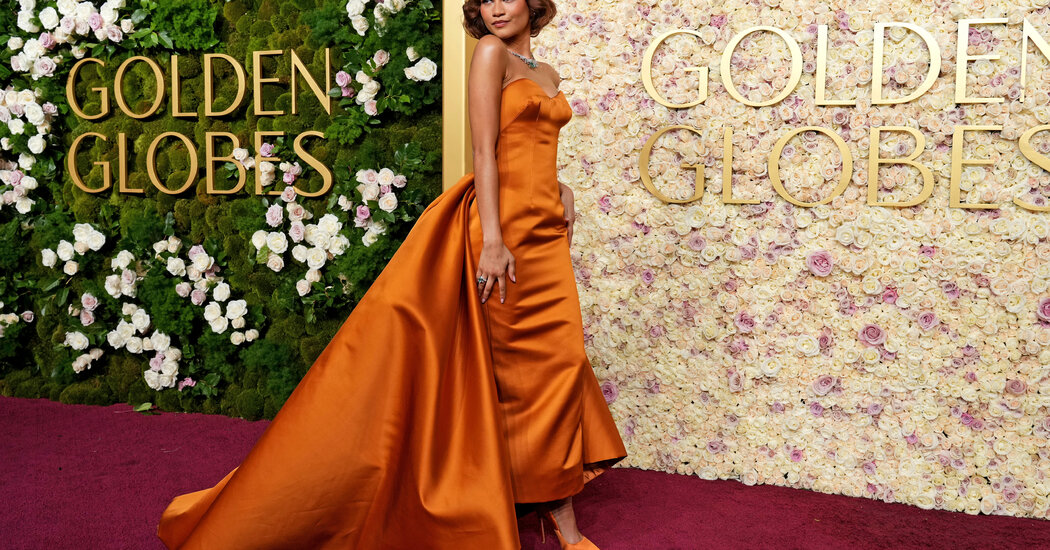Hollywood may be a famously liberal city, but it’s starting to look more and more conservative. At least that’s how it seemed at the Golden Globes, the first official red carpet and communal fashion competition of the year — and thus, in theory, the pacesetter for 2025, or at least the 2025 awards season.
The biggest trend of the night wasn’t the usual stars dressing up as figurines, although there were plenty of those (hello, Mindy Kaling at Ashi Studio and Mikey Madison at Bottega Veneta) or stars dressing to match the carpet (see Dakota Fanning in Tony Ward and Emma Stone in Louis Vuitton). Rather, the most noticeable trend was a retro-classicism that made the event resemble a cosplay convention for Olde Tinsel Town. Forget throwback Thursday; think about sunday, send me back.
Ariana Grande set the tone by doing her best Audrey Hepburn impression in a buttery silk 1966 couture column from Givenchy (the 1960s were the height of Hepburn and Hubert’s fashion partnership).
Then there was Selena Gomez channeling Jackie Kennedy in ice blue Prada and a styled bob; Nicole Kidman and Margaret Qualley with huge, exuberant ponytails by Catherine Deneuve, which set off their Balenciaga and Chanel dresses; and Elle Fanning and Monica Barbaro in newfangled Balmain and Dior versions of old-fashioned 1950s ball gowns. Not to mention Pamela Anderson in a Madame X Oscar de la Renta and matching black opera gloves, with opera gloves being one of the most popular accessories of the evening.
By the time Zendaya, normally one of the most adventurous dressers on any carpet, appeared in a strapless satin Louis Vuitton dress with matching overskirt, created in tribute to 1950s black artist Joyce Bryant, it was clear that there was something…um, nostalgic going on. on. And that’s not even counting the sea of traditional tuxedos in the room.
This certainly has something to do with the well-documented Hollywood neurosis about looking foolish, which arose in the last century when Joan Rivers unleashed her inner Chihuahua on the red carpet denizens, the worst-dressed list emerged and the stylist became the new became. power broker in the fashion-film industrial complex.
Despite the numerous brand ambassadorships that connect celebrities and fashion designers, most designers create at the request of those stylists, whose primary goal is to serve the comfort of their customer. And what could be more comfortable than eschewing your own taste and role-playing as a Pinterest board full of style stars from the past? Zendaya’s dress would never have been recognizable as Vuitton if she wasn’t officially a face of the brand.
But part of the trend is probably also related to the mood of the moment and the promise (and fear) of the coming presidential administration, with its bombastic, celluloid veneration for the days of yore when America – and Hollywood – ruled the world and the people ruled. wore ties and women wore pointy bras and (yes) gloves. Well, it happens politically. Why not tailoring? Furthermore, when you’re not sure what’s going to happen, it’s safest to retreat into the certainty of the past, especially when you’re bathed in the soft glow of the dream machine.
The problem is that even though these women and men all looked very glamorous, and many of them made all kinds of best-dressed lists, they didn’t look modern. They didn’t even look like they were having that much fun with fashion. Nothing about these styles challenged established clothing norms, or created new ones.
Maybe the red carpet isn’t the place for that. Maybe that’s the runway’s job. But given the increasingly interdependent relationship between fashion and film (this time epitomized by Saint Laurent, which not only produced “Emilia Pérez” but also dressed stars Zoe Saldaña and Karla Sofía Gascón), that increasingly looks like a false dichotomy . . Part of the red carpet’s job is to translate the interesting parts of the runway into semi-real life.
With the exception of a few outlier experimentalists – Ayo Edebiriwho seemed delighted in a Loewe pantsuit with an extra-long gold feather tie; Ali Wong in red Balenciaga, with her hair down and her signature dark-rimmed glasses; Jeremy Strong in a jade green Loro Piana suit with matching bucket hat and glasses that made him look like a leprechaun magnate – that didn’t happen.
Sure, those looks were weird. But they weren’t remotely retro, and they were memorable in that earworm-like way that burrows into the cerebral cortex, marinates for a while, and then begins to influence fashion broadly. They had the courage of their own convictions.
Like the Globes, where the biggest awards of the night went to the indie and the edgy – “Emilia Pérez” and “The Brutalist,” as well as the come-from-behind best actress and actor wins from Demi Moore for “The Substance” and Sebastian Stan for “A Different Man” – reflected everything, it was the power and value that comes from daring to be different and pursuing a unique vision.
We hope that as the rest of the red carpet unfolds leading up to the Oscars, people will start dressing appropriately.





